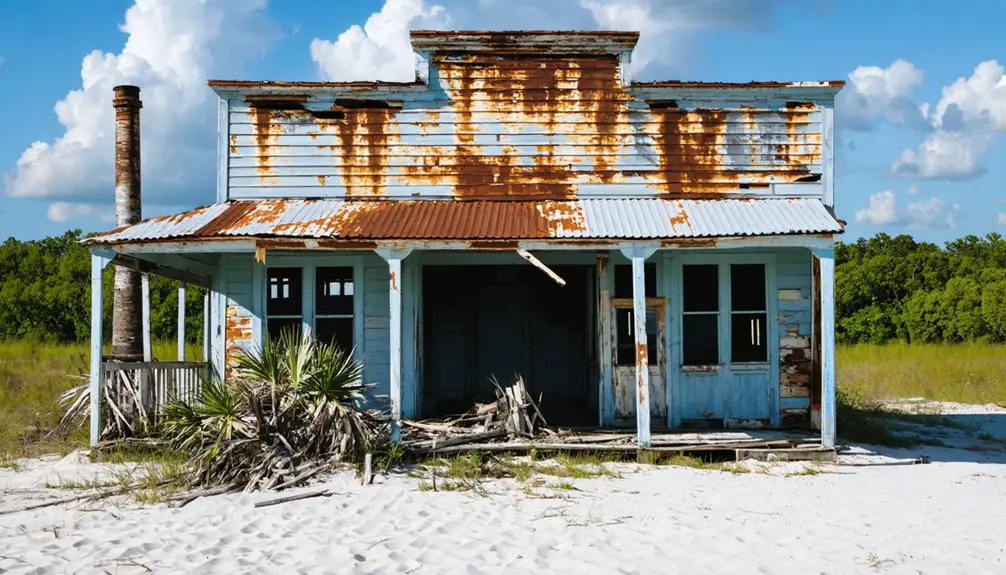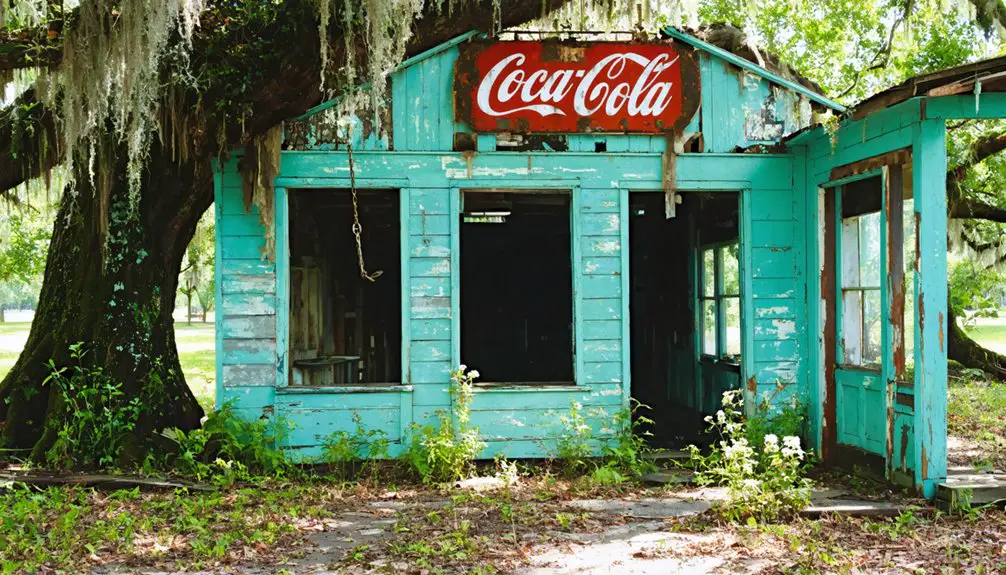You’ll find Fort Basinger, established in 1837 during the Second Seminole War, along the Kissimmee River‘s south bank in Florida. This military outpost-turned-settlement thrived during the steamboat era of the 1880s, with the Daughtrey brothers establishing the first white settlement. While the fort’s original structures haven’t survived, you can still visit the historic Basinger Cemetery from 1896 and explore scattered foundations that hint at this ghost town’s rich frontier past.
Key Takeaways
- Originally established as Fort Basinger in 1837 during the Second Seminole War, the settlement later evolved into a civilian community.
- Located along the Kissimmee River, Basinger thrived during the steamboat era but declined when railroads bypassed the town.
- Economic activity peaked between 1880-1915, with steamboat trade serving as the primary means of transportation and commerce.
- Today, Basinger is largely abandoned, with only one historic homestead and the Basinger Cemetery remaining from the original townsite.
- The town’s decline was primarily due to transportation shifts, with automobiles replacing steamboats and major railroads avoiding the area.
The Birth of Fort Basinger During the Seminole Wars
During the Second Seminole War in late December 1837, Colonel Zachary Taylor ordered the construction of Fort Basinger, a stockaded military outpost situated on the Kissimmee River’s south bank in present-day Highlands County, Florida.
You’ll find the fort’s significance rooted in its strategic positioning, which supported military operations advancing toward Lake Okeechobee and the heart of Seminole resistance. The fort was named after Lieutenant William E. Basinger, who’d fallen in the Dade Massacre two years earlier.
Early military strategies centered on establishing this fortified position with two blockhouses and a log palisade, providing an essential supply post between Fort Brooke and Lake Okeechobee. The structure was built entirely using pine logs as primary construction material. The fort’s effectiveness was tested during the Battle of Lake Okeechobee, where U.S. forces engaged in a significant clash with Seminole warriors.
Under Captain Monroe’s command, the fort housed one company of soldiers and 85 sick men, along with allied Native Americans.
From Military Post to Thriving Settlement
Following its active military service through the Third Seminole War, Fort Basinger evolved from a strategic military outpost into a growing civilian settlement.
Fort Basinger transformed from a military stronghold into a pioneering community after serving in the Third Seminole War.
The fort’s military logistics infrastructure, which had supported troop movements and medical care, provided a foundation for early community development. You’ll find that settlers were drawn to the area’s advantageous location along the Kissimmee River, which facilitated transportation and trade opportunities. The site’s original construction with pine log stockades influenced early settler building practices. After the Indian Wars concluded, the fort was abandoned, marking a transition to civilian development.
The community’s resilience manifested through its economic diversification, changing from military-support services to agriculture, forestry, and river-based commerce.
While the original fort structures weren’t preserved, the settlement grew to include homesteads, trading posts, and eventually gained connection to broader regional networks via U.S. Highway 98.
Today, just one historic homestead remains as a reflection of this once-thriving frontier community.
Life Along the Kissimmee River
As the Daughtrey brothers from East Tennessee established themselves as the first white settlers in Basinger, life along the Kissimmee River centered around water-based commerce and ambitious development schemes. During this period, Fort Basinger’s ruins still marked the landscape as a reminder of the Seminole Wars.
Mary Belle steamer navigated the river until its sinking in 1884, marking the beginning of regular steamboat service in the region. You’d find steamboats plying the waters, bringing settlers and transporting goods while river wildlife flourished along the banks. The Southern Colonization Company marketed ten-acre parcels to hopeful farmers, even establishing demonstration farms and a hotel at Hunters Camp.
Despite early optimism, agricultural challenges proved insurmountable. The land you’d hoped to farm wasn’t suitable, and the promised railroad never reached Basinger.
When the Kissimmee Valley Extension railroad arrived in Okeechobee in 1915, it drew commerce away from the river. Many residents relocated, leaving behind their dreams of farming prosperity along the Kissimmee’s shores.
The Golden Age of Steamboats and Commerce
The arrival of steamboat trade in the 1880s transformed Basinger from an isolated settlement into an essential commercial hub along the Kissimmee River.
After Hamilton Disston dredged the waterway in 1881, steamboat innovations revolutionized the region’s commerce. You’d find vessels like the Mary Belle and the Bassinger making three weekly stops, carrying everything from alligator hides to citrus fruits.
The economic impact was profound. River landings became vibrant centers where you could trade goods, exchange news, and connect with the outside world. John Mizell Pearce operated a ferry service helping travelers cross between Basinger’s bustling shores.
Cracker cowboys used their signature whips to drive cattle near the riverbanks as they transported livestock to market.
Captains like Benjamin Hall and Clay Johnson operated vessels that linked Basinger to Kissimmee’s railroad network, fostering a thriving cowboy community.
This golden age of river commerce lasted until 1915, when automobiles and new highways began replacing waterborne transportation.
Notable Families and Early Pioneers
When Arthur and Thomas Daughtrey ventured from east Tennessee to establish the first white settlement in Basinger, they initiated a wave of pioneering families who’d shape the region’s future.
The Pearce family soon followed, building a pine log home and launching successful cattle operations near the Kissimmee River fort site.
By 1870, the Parker, Holmes, Raulerson, Chandler, and Underhill families had joined the growing settlement.
Wealthy cattleman Eli Morgan relocated from Pine Level before 1885, while Jeremiah Walker arrived from Brevard County during the same decade.
These early settlers combined cattle ranching with alligator and raccoon hunting, developing a distinctive Florida cowboy culture known for its use of the braided buckskin whip.
Their entrepreneurial spirit transformed Basinger into a thriving cowboy community with hotels and stores serving as social and commercial hubs until the early 1900s.
The Impact of Railroad Development
Despite ambitious plans by the South Florida and Gulf Railroad to connect Basinger with major transport routes, the rail line’s terminus at Prairie Ridge, 12 miles north, marked a pivotal setback for the settlement’s development.
You’ll find that this railroad bypass proved catastrophic for Basinger’s future, as the Florida East Coast Railroad’s decision to route through Okeechobee in 1915 triggered a devastating economic decline.
The Southern Colonization Company’s vision of transforming Basinger into an agricultural hub crumbled when the rail extension failed to materialize. Local farmers couldn’t efficiently transport their goods, and the weekly wagon trips to Prairie Ridge’s depot weren’t sustainable.
The area’s isolation deepened further as Henry Flagler’s railway focused on developing coastal communities, leaving inland settlements like Basinger to fade into obscurity.
Remnants and Relics of a Lost Town

Located along the south bank of the Kissimmee River, modern-day Basinger’s remnants paint a sparse picture of its former existence.
If you venture to this ghostly settlement today, you’ll find just one historic homestead remains from the original townsite, while the fort’s temporary log structures have long since vanished.
Most physical traces have surrendered to time and vegetation, though artifact discoveries occasionally surface near the original fort site.
- The Basinger Cemetery, established in 1896, stands as the most significant historical marker
- You’ll find no intact military structures, only scattered foundations beneath the wild growth
- The former Lockett Estate area preserves abandoned residential markers on private land
- Cemetery visits reveal haunting glimpses of the past through weathered headstones and markers from the Methodist Episcopal Church South
Preserving Basinger’s Historical Legacy
Although Basinger’s physical remnants have largely faded into Florida’s landscape, various preservation efforts seek to protect its historical legacy.
You’ll find cultural preservation initiatives focused on protecting key sites like the Pearce family cemetery, which has been fenced to prevent damage from wild hogs. The South Florida Water Management District attempted to partner with other agencies to maintain the Pearce-Lockett residence as a heritage site before selling it at auction in 2017.
Community engagement remains critical, as local entities work to preserve what’s left of Basinger’s history. The Basinger Cemetery, established in 1896, continues to mark the community’s historical continuity, while deteriorating structures like the boathouse and concrete lamp posts along the Kissimmee River await urgent conservation attention.
Frequently Asked Questions
Are There Any Paranormal Activities Reported in the Abandoned Structures of Basinger?
You won’t find any documented ghost sightings in Basinger’s abandoned buildings. Despite the area’s military history and deteriorating structures, there’s no verified evidence of paranormal activity at these locations.
What Wildlife Species Currently Inhabit the Former Town Site?
You’ll find abundant wildlife sightings around the site, including white-tailed deer, wild hogs, alligators, herons, egrets, and various reptiles, reflecting the rich species diversity of Florida’s wetland ecosystem.
Can Visitors Legally Access and Explore the Basinger Ghost Town Today?
You can’t legally access this ghost town without owner permission, as regulations restrict entry to private property. Safety concerns from deteriorating structures make unsupervised exploration dangerous and potentially unlawful.
What Happened to the Artifacts From Basinger’s Original General Store?
You won’t find the original store’s artifacts today – their historical significance has been lost due to lack of artifact preservation. Most items were likely dispersed or destroyed as Basinger declined.
Did Any Movies or Television Shows Ever Film in Basinger?
Searching solitary spaces reveals no film history here. Despite location scouting throughout Florida, you won’t find any documented evidence of movies or television shows ever filming in this remote settlement.
References
- https://www.lamartin.com/history/history_of_okeechobee_county/chapter2.htm
- https://www.legendsofamerica.com/fort-basinger-florida/
- https://abandonedfl.com/lockett-estate/
- https://cyndi-lenz.com/2015/06/28/traveling-florida-back-roads-fort-basinger-and-the-lockett-estate/
- https://en.wikipedia.org/wiki/Fort_Basinger
- https://en.wikipedia.org/wiki/Fort_Basinger_(Seminole_War_Fort)
- https://www.lamartin.com/history/history_of_okeechobee_county/chapter1.htm
- https://www.hoboewanderings.com/fortbasinger
- https://kids.kiddle.co/Fort_Basinger_(Seminole_War_Fort)
- https://www.lamartin.com/history/pioneer_families_kissimmee_river_valley.htm



